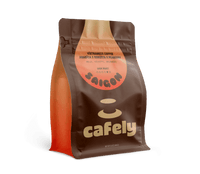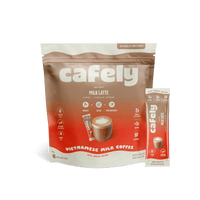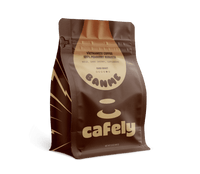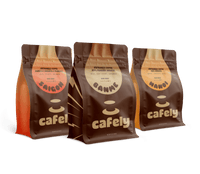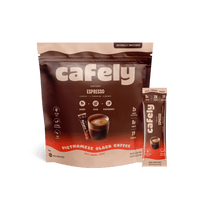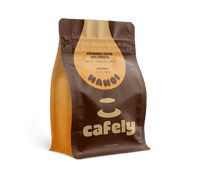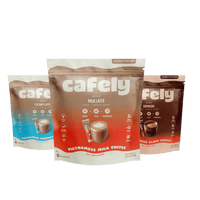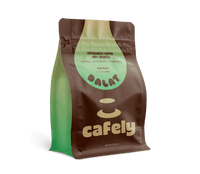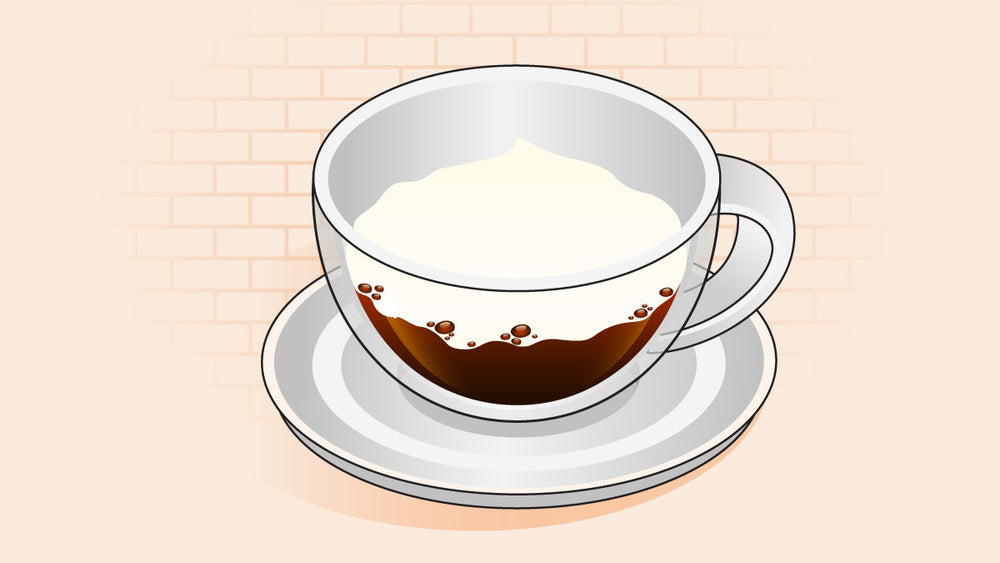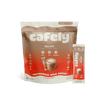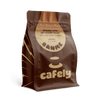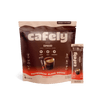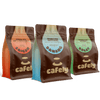Maybe you've heard someone order it, and now you're curious. A bone-dry cappuccino is one of those café drinks that sounds intense, but it's really just a twist on a classic.
Cappuccinos are one of the more familiar espresso drinks, built from equal parts espresso, steamed milk, and foam. That simple balance makes them smooth, rich, and endlessly customizable.
But if you adjust the milk-to-foam ratio, you move into "wet" or "dry" territory. And at the driest end of the spectrum? That's where the bone-dry cappuccino comes from.
What Is a Bone-Dry Cappuccino?
A bone-dry cappuccino is a variation of the traditional cappuccino made with only two components: espresso and milk foam. What it deliberately skips is the steamed milk in between.
Here’s the breakdown:
- Bone dry cappuccino = espresso + milk foam (no steamed milk at all)
- Traditional cappuccino = ⅓ espresso + ⅓ steamed milk + ⅓ foam
By removing the steamed milk, the result is a stronger espresso flavour with a lighter, airier mouthfeel. The thick layer of foam sits on top of the espresso, giving you the creamy cap that defines a cappuccino, just without any dilution from milk.
Bone-dry cappuccinos are especially popular with people who:
- Prefer the intensity of espresso
- Enjoy the texture of dense milk foam
- Want a lower-calorie version of their usual coffee order
- Dislike steamed milk but still want that café-style presentation
It’s a drink that puts the espresso centre stage while still offering the comfort and texture of foam.
Bone Dry vs. Other Cappuccino Styles
The phrase “bone dry” might sound dramatic, but in the world of cappuccinos, it refers to a very specific milk-to-foam ratio.
Most cappuccino styles are named based on how “wet” or “dry” they are, in other words, how much steamed milk is included compared to foam.
Here’s a quick breakdown of how bone dry compares to other popular cappuccino styles:

A wet cappuccino leans closer to a latte, delivering a creamy, smooth texture that softens the espresso’s boldness.
A traditional cappuccino strikes a balance, where you get structure from the foam, warmth from the milk, and body from the espresso.
The bone-dry cappuccino, though, skips the milk entirely. What you get is a rich, concentrated shot of espresso crowned with a pillowy cloud of milk foam. It's airy, bold, and unapologetically coffee-forward.
How to Choose the Best Coffee for Bone Dry Cappuccino
Because there's no steamed milk to mellow out the shot, the espresso in a bone-dry cappuccino needs to stand on its own. The roast, grind, and bean origin all play a major role in how your final cup will taste, and getting it right makes all the difference.
1. Start with Fresh, High-Quality Espresso Beans
The best bone-dry cappuccinos begin with beans that have been recently roasted and stored properly.
Freshness matters because not only does it affect the crema, but it also impacts the richness and clarity of the espresso shot. Look for beans for cappuccino roasted within the last 2 to 4 weeks and grind them just before brewing.
2. Medium to Dark Roasts Bring Boldness Without Bitterness
A medium or dark roast is ideal for bone-dry cappuccinos. These roasts extract rich, chocolatey, and toasted notes without being overly acidic. Lighter roasts, while bright and complex, often taste too sharp in a dry-style drink.
For that reason, blends like Cafely’s SaiGon OG work beautifully here. This medium-dark roast balances strength and nuance by combining Robusta, Arabica, and Peaberry beans. You get a bold base from the Robusta, while the Arabica adds smoothness and subtle floral tones.
The result is rich, layered espresso with a flavor that can stand proudly under a dome of foam.
3. Arabica vs Robusta: A Matter of Texture and Taste
Arabica beans are prized for their clean, complex profiles, fruity, nutty, or sweet. They make for smooth, refined espresso with low bitterness. Robusta beans, on the other hand, have more caffeine, deeper earthiness, and a thick, creamy crema.
Blends that use both, like SaiGon OG or DaNang Coffee, offer the best of both worlds. DaNang’s roast combines Arabica and Robusta to produce a profile that ranges from hazelnut and maple syrup to citrus zest.
4. Single-Origin Beans Deliver Clarity in Every Sip
If you prefer purity over balance, single-origin beans are your friend. They offer focused flavors tied to the region's soil, climate, and processing method. In a bone-dry cappuccino, that clarity isn't lost behind milk; it's elevated.
Take Cafely’s DaLat Coffee, made entirely from Vietnamese Arabica beans grown in the Da Lat highlands. This roast is smooth, rich, and decadent, with notes of caramel, blackberry, and stone fruit.
5. The Grind and Prep Make or Break the Shot
Bone-dry cappuccinos depend on strong, well-extracted espresso. That means a fine espresso grind, not coarse like drip coffee, and not powdery like Turkish coffee, to create the right pressure and crema during brewing.
Always grind just before brewing, and use filtered water at the correct temperature (around 195 to 205°F or 90°Celsius). If you’re using a machine like a Nespresso or Moka pot, make sure it’s clean and preheated.
How to Make a Bone-Dry Cappuccino at Home

Here's how to master bone-dry cappuccino at home, step by step.
Step 1: Brew a Strong Espresso Base
Use a high-quality machine, manual espresso maker, or Moka pot to brew 1–2 shots of espresso.
Grind fresh beans to a fine espresso texture (like powdered sugar). Use 18–20 grams for a double shot, tamp firmly, and extract slowly.
If using a Moka pot, pull it off the heat as soon as the top fills to avoid bitterness.
Step 2: Froth Milk into Dry Foam Only
Use 6–8 oz of cold whole milk or a creamy alternative.
Froth with a steam wand just below the surface, keeping it airy for stiff, dry foam (not silky microfoam).
No steam wand? Use a handheld frother or whisk until it’s light, fluffy, and holds peaks.
Stop frothing around 140°F (60°C) to avoid scalding.
Step 3: Layer the Drink Properly
Pour the espresso into your cup first.
Then gently spoon on the dry foam — skip the liquid milk entirely.
The final drink should be espresso topped only with thick, airy froth.
Step 4: Finish with a Touch of Flavour (Optional)
If you want to add a finishing note without compromising the texture, sprinkle a bit of unsweetened cocoa, cinnamon, or nutmeg on top of the foam.
These toppings add aroma and visual appeal without introducing extra moisture.
Avoid drizzling syrups or sauces; they’ll weigh down the foam and break the “dry” structure of the drink.
FAQs: Bone-Dry Cappuccinos
Let’s clear up the most common questions about bone dry cappuccino.
1. What Is the Point of a Dry Cappuccino?
It gives you all the intensity of espresso, but with a soft, textured foam on top instead of milk to dilute the flavour.
2. What Is the Difference Between a Dry Cappuccino and a Macchiato?
A macchiato has just a spoonful of foam on espresso, while a dry cappuccino has a full cap of foam with no milk underneath.
3. What’s the Difference Between a Latte and a Cappuccino?
A latte has more steamed milk and a creamier texture; a cappuccino has less milk and more foam, making it stronger in taste.
4. Which Is Healthier: Cappuccino or a Macchiato?

Macchiatos usually have fewer calories since they use less milk, but it depends on size and any extras added.
5. What Does a Bone-Dry Cappuccino Taste Like?
It’s strong, rich, and espresso-forward, with a layer of light foam that softens the bitterness without adding creaminess.
6. What Does the Saying “Bone Dry” Mean?
In coffee terms, it means absolutely no steamed milk, just espresso and foam.
7. Is Cappuccino the Strongest Coffee?
Not quite. While it’s bold, straight espresso or ristretto shots have more caffeine per ounce and hit harder.
8. What Grind of Coffee Has the Most Caffeine?
Caffeine levels depend on the bean and brew time, and grind size affects extraction, but not how much caffeine is in the bean itself.
9. What Is the Difference Between Bone Dry and Air Dry?
“Bone dry” refers to the style of cappuccino; “air dry” is a drying method for clothes or materials that uses no heat.
10. What Is the Weakest Coffee To Drink?
Instant coffee or long-brewed drip coffee often has the lowest caffeine concentration per ounce, especially when diluted with milk.
